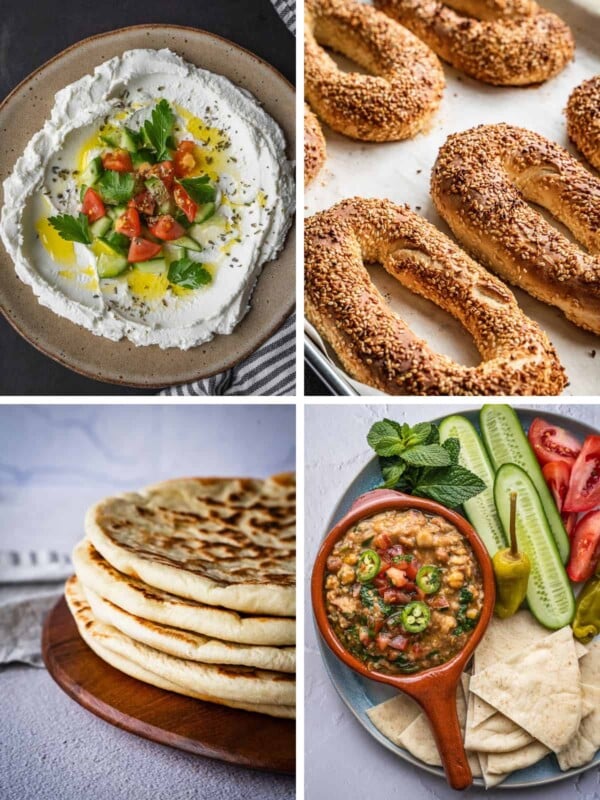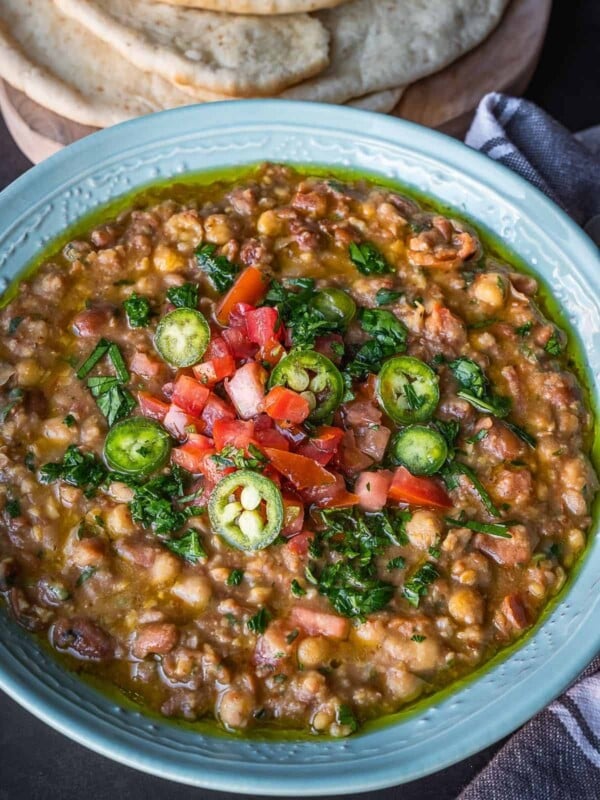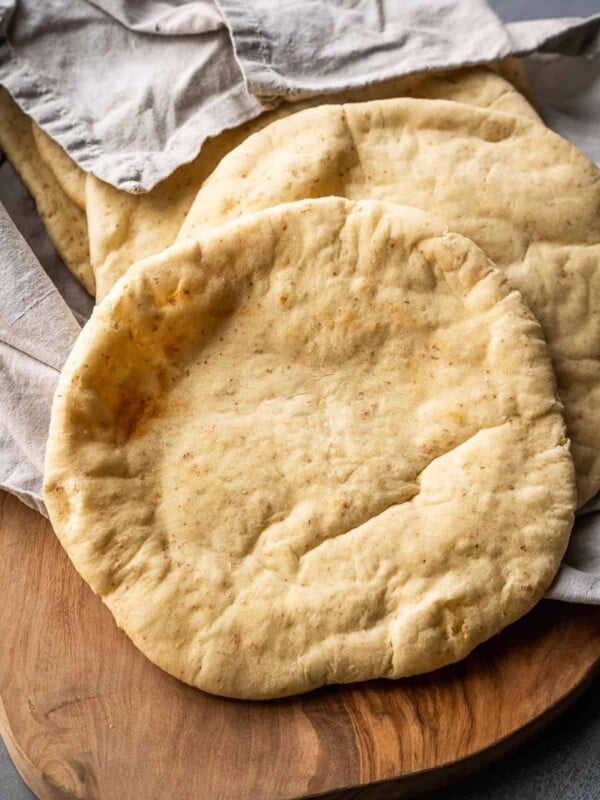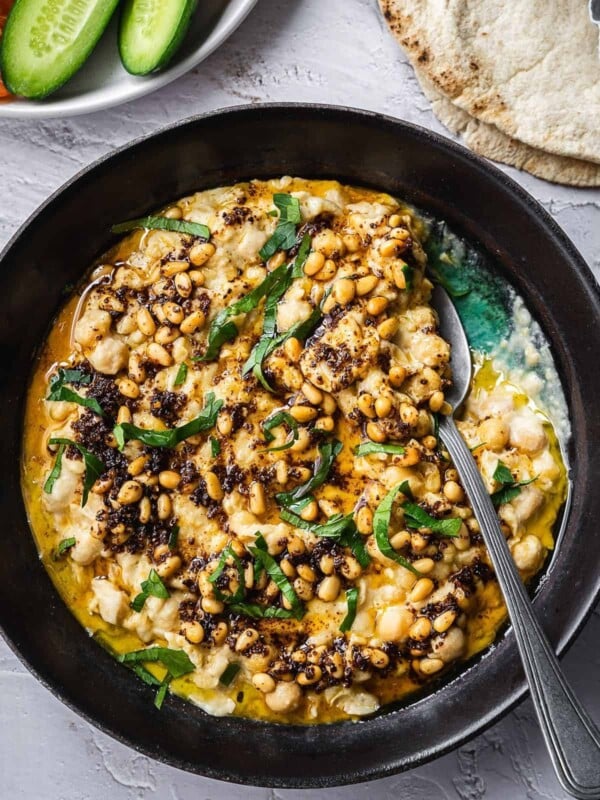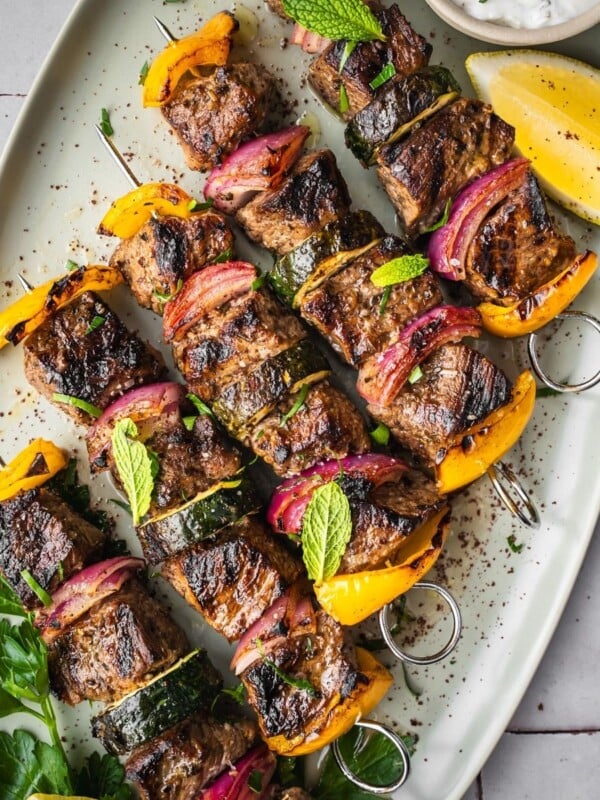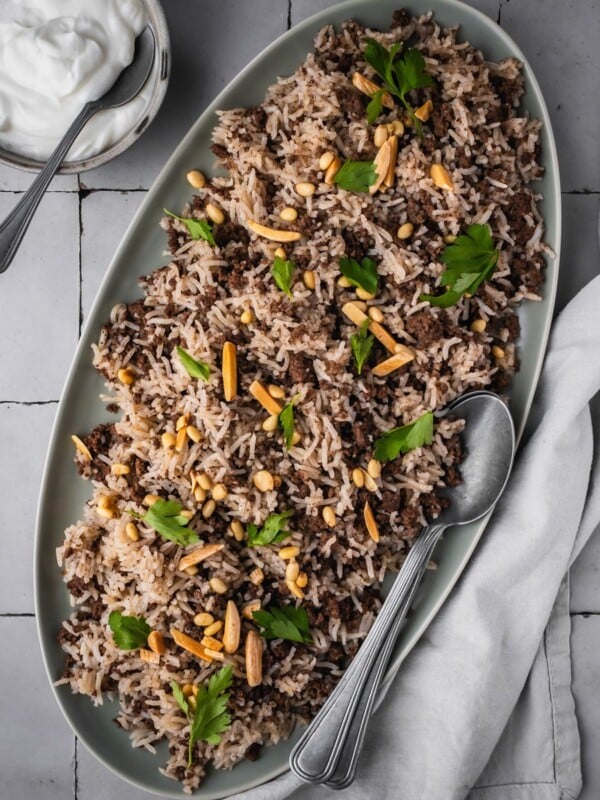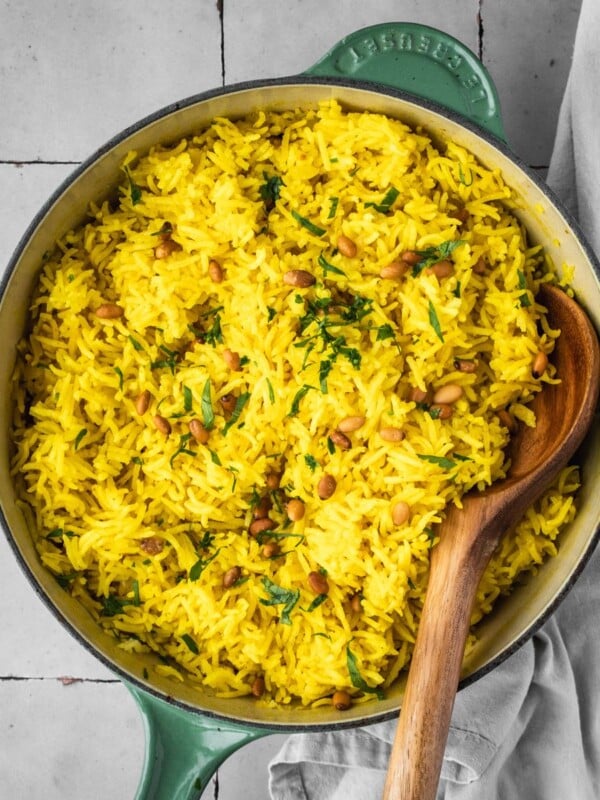Fattet hummus is a warm and comforting breakfast dish of toasted pita chips, chickpeas, hummus, yogurt and other toppings. Serve with other Levantine breakfast classics. This recipe comes together in less than 30 minutes!

Table of Contents
A dish by many names, you will often find Fattet Hummus referred to as Hummus Fatteh or Chickpea Fatteh. It is closely related to Musabaha (creamy chickpea strew). There are several versions of this recipe, depending on where you grew up, your family background and family preferences.
I wrote this recipe in a way to make it easy and simple for you to prepare. I encourage you to check out some of my other breakfast recipes like Ful Mudames (stewed fava beans), Za’atar Manakish and Cheese Fatayer.
Ingredients
What I love about this recipe is that many of the ingredients are pantry and fridge staples you probably already have right now!

- Chickpeas. Canned chickpeas all the way! But if you want to boil dry beans, see the expert tips below.
- Tahini. Tahini is a must. If you don’t have it, I wouldn’t recommend you proceed with the recipe just yet. Pick up some tahini from your local supermarket, Middle Eastern grocery stores or online. You can use it to make many other recipes like my Caramelized Eggplant Hummus, Mutabal and Shishitos with Tahini Sauce.
- Yogurt. I recommend using a plain or Balkan-style yogurt. It will be less thick than Greek and blend well with the hummus. If you only have Greek yogurt, no problem. You may need to dilute the hummus mixture with more cooking liquid or water to get a runnier consistency.
- Pine nuts. Pine nuts are traditional, but they are pricy (especially the good quality European or Lebanese ones). You can use sliced almonds instead, or omit the nuts entirely.
- Pomegranate Seeds. The seeds are used to give color to this otherwise beige dish and for a burst of flavor, sweetness and acidity that complements the rich creaminess of the hummus mixture.
- Herbs. Parsley is traditional, but some people also like to add mint. The choice is yours.
See the recipe card for full information on ingredients and quantities.
How to Make Fattet Hummus

1. Bake Pita. Preheat your oven. On a parchment paper lined baking sheet, place the pita squares and drizzle with a little olive oil. Toss and lay in a single layer (Image 1). Bake until crisp, but not too browned (Image 2).
2. Boil chickpeas. Empty the contents of a can of chickpeas (and the water) in a small pot. Bring to a gentle simmer to warm through (Image 4). Save about ¼ cup of chickpeas and chickpea broth in a small bowl. You’ll need it later (Image 4).

3. Make Hummus. To a food processor, add the warm chickpeas from the pot, tahini, lemon juice, garlic, cumin, a big pinch of salt and fresh cracked pepper (Image 5). Process until smooth (Image 6).
4. Add Yogurt. Add the yogurt to the food processor (Image 7). Process until smooth and incorporated. Taste and adjust the seasoning (Image 8). The hummus should be slightly runny, not like you would expect for a regular hummus dip. Add some of the liquid from the pot to help thin it if necessary.

5. Toast Pine nuts. To a small frying pan, add the olive oil and pine nuts (Image 9). Fry on medium heat until they begin to brown (Image 10). Be careful, the pine nuts will burn quickly. Transfer to a paper towel-lined plate (Image 11).
6. Prepare toppings. Prepare all the toppings and set aside (Image 12).

7. Assemble. Start by adding all the toasted pita to your serving dish or bowl (Image 13). Layer on the runny hummus and yogurt mixture (Image 14). Scatter the whole chickpeas and liquid you set aside (Image 15). Garnish with fresh parsley, pomegranate seeds, and toasted pine nuts (Image 16).
Expert Tips
- Make your own Pita! My recipe for homemade Lebanese Pita Bread is the perfect base for this recipe.
- Use Dry Chickpeas (Optional, not recommended). If you prefer to make the chickpeas from scratch, simply soak dry chickpeas overnight in cold water. Cook the chickpeas until tender in a pot of water or in a pressure cooker as per the manufacturer’s directions. I still think you should use canned, as it’s much easier and less work with minimal flavor difference.
- Don’t burn the nuts! Don’t step away from the stove when toasting the nuts. They will burn and turn bitter quickly. It’s best to turn off the stove right away when they begin to brown as the residual heat in the oil will continue to toast them. If you burn them, start over!
- Serve right away. The pita chips will become soggy if you let the fatteh sit for too long.

Recipe FAQs
The Arabic word “fatteh” (فتّة) refers to a popular Levantine dish that consists of pieces of pita bread (often stale or toasted), topped with various ingredients and sauces. The dish varies across regions and cultures, but a common preparation involves a base of bread pieces topped with layers of ingredients such as chickpeas, yogurt, tahini, and sometimes meat.
It is often garnished with ingredients like pine nuts, herbs and pomegranate seeds. The combination of textures and flavors in fatteh makes it a flavorful and satisfying dish enjoyed in many Middle Eastern cuisines.
I don’t recommend you make the full recipe ahead of time. You can make the toasted pita chips, the yogurt hummus mixture and the toppings in advance, but keep them all separate until you are ready to serve.
This recipe does not keep well. The pita chips will get soggy and the hummus mixture will thicken. Make only as much as you need.
Yes. The word fattet used in this recipe is based on common spelling and the way the dish is pronounced.
Other Levantine Breakfast Recipes
Levantine Recipes
Levantine Recipes
Recipes
Levantine Recipes
If you make this Fattet Hummus (Chickpea Yogurt Fatteh Recipe) or any other Levantine Recipe on Urban Farm and Kitchen, please take a moment to rate the recipe and leave a comment below. It’s such a help to others who want to try the recipe.
For more Urban Farm and Kitchen, follow along on Instagram, Facebook, and Pinterest, visit the Urban Farm Shop, or subscribe for new posts via email.
Fattet Hummus (Chickpea and Yogurt Fatteh)
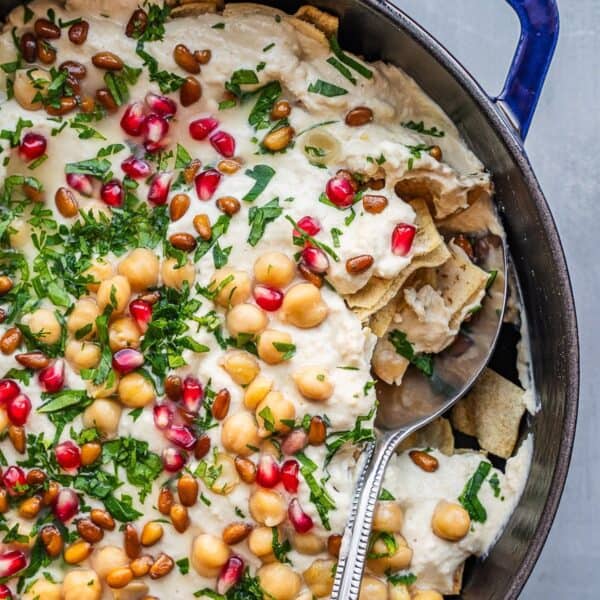
Ingredients
Toasted Pita Chips
- 3 Thin Pita breads – cut into 1 inch squares
- Olive oil for brushing
Hummus and Yogurt Mixture
- 1 can Chickpeas – 19 ounces or 540ml
- ¼ cup Tahini
- 1 ½ cups Plain yogurt – See note for Greek yogurt
- 1 tsp Cumin – Ground, use more or less to taste
- 1-2 Garlic cloves – Peeled
- 1 Lemon – Juiced
- Salt and pepper to taste
Garnish
- 2 tbsp Pine nuts – You can also use slivered almonds
- 2 tbsp Olive oil
- 2 tbsp Fresh parsley – Finely chopped
- 2-4 tbsp Pomegranate seeds
- Paprika, Aleppo pepper for garnish – Optional
Instructions
- Bake Pita. Preheat your oven to 350F/180C. On a parchment paper lined baking sheet, place the pita squares and drizzle with a little olive oil. Toss and lay in a single layer. Bake until crisp, but not too browned, about 5-8 minutes. Toss the pita chips as needed to get them to evenly bake.
- Boil chickpeas. Empty the contents of a can of chickpeas (with its water) in a small pot. Bring to a gentle simmer to warm through. Save about ½ cup of chickpeas and chickpea broth in a small bowl and set aside. You’ll need it later.
- Make Hummus. To a food processor, add the warm chickpeas from the pot, a splash of the cooking liquid, tahini, lemon juice, garlic, cumin, a big pinch of salt and fresh cracked pepper. Process until smooth, 60-90 seconds.
- Add Yogurt. Add the yogurt to the food processor. Process until smooth and incorporated. Taste and adjust the seasoning. The hummus should be slightly runny, not like you would expect for a regular hummus dip. Add some of the hot water from the pot to help thin it if necessary. The runny consistency is needed to help soften the pita chips later.
- Toast Pine nuts. To a small frying pan, add the olive oil and pine nuts. Fry on medium heat until they begin to brown. Be careful, the pine nuts will burn quickly. Transfer to a paper towel-lined plate.
- Prepare toppings. Prepare all the toppings and set aside.
- Assemble. Start by adding all the crispy pita chips to your serving plate or large platter. Layer on the runny hummus and yogurt mixture. Scatter the whole chickpeas and liquid you set aside. Garnish with fresh parsley, pomegranate seeds, and toasted pine nuts.
Notes
- I recommend using canned chickpeas. You can boil your own dry beans if you prefer, but you really don’t need to.
- I recommend using a plain or Balkan-style yogurt. It will be less thick than Greek and blend well with the hummus. If you only have Greek yogurt, no problem. You may need to dilute the hummus mixture with more cooking liquid or water to get a runnier consistency.
- Go Vegan! Use a plant-based yogurt instead. Everything else in the recipe is vegan so that’s the only sub you need to make.
- You can use melted butter or melted ghee instead of olive oil when frying the pine nuts.
- Pine nuts are traditional, but you can also use slivered or sliced almonds.
- Fresh parsley is a traditional garnish, but you can also use fresh mint.
Nutrition
Nutrition information is automatically calculated, so should only be used as an approximation.
 Like this recipe? Rate & comment below!
Like this recipe? Rate & comment below!